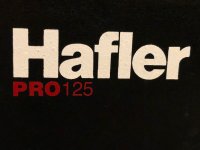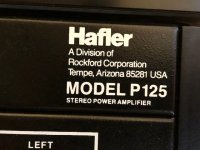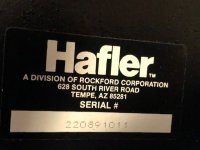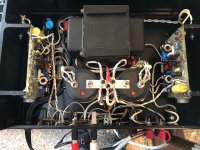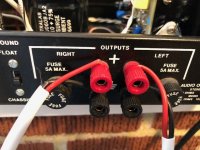Looking for a PDF of the manual for a Hafler P-125.
Also wondering what a reasonable output fuse size would be to provide some protection to the amplifier. Has a 0.2A which opened when I unplugged the input. Back panel says 5A max, which is probably too big. Will replace with a 0.2A in the mean time. (Usually people who have some experience with the equipment have a good idea of what provides reasonable protection so that's why I ask.)
Also wondering what a reasonable output fuse size would be to provide some protection to the amplifier. Has a 0.2A which opened when I unplugged the input. Back panel says 5A max, which is probably too big. Will replace with a 0.2A in the mean time. (Usually people who have some experience with the equipment have a good idea of what provides reasonable protection so that's why I ask.)
Attachments
Thanks George. Was hoping to find the exact manual (with schematics) to make it easier to service in the future. I am surprised I can't find it on the Internet anywhere...
- Greg
Was hoping to find the exact manual (with schematics) to make it easier to service in the future.
It seems they are identical internally.
Here is what my P-125 looks like inside. Separate PCBs and fuses on the outputs. The SE120 manual shows a single PCB and no fuses on the outputs. Not sure if the circuitry is the same or not though.
I see Vintage Electron has original manuals on eBay for $14.95...
A PDF would work for my purposes. If I can find one.... ;-)
I see Vintage Electron has original manuals on eBay for $14.95...
A PDF would work for my purposes. If I can find one.... ;-)
Attachments
...reasonable output fuse size... Will replace with a 0.2A in the mean time. ...
I used 2A fuses on smaller amplifiers.
Rated 60W in 8 Ohms implies 2.7 Amps at FULL test-tone power, which it should survive for days. There is no 4 Ohm rating, but we know 4 Ohms "happens", and 90W in 4r is 4.7A, so a 5A fuse _is_ reasonable.
While the peak/average of speech/music is low, I would expect a 1A fuse to blow "occasionally" in strong but clean playing. I'd expect a 0.2A fuse to blow frequently for no good reason.
Also: fuses distort, and small fuses distort more. They have higher resistance and lower thermal mass.
The outputs are MOSFETs. These are not blowout-proof, but seem to do OK without explicit V/A limiting like all big BJT amps "need". The unprotected MOSFET amps seem to do OK in PA use which is far more demanding than your livingroom.
I'd go at-least 3 Amps. I see no reason to avoid the factory 5A advice.
Thanks! Exactly the sort of advice I was looking for. Three amps it is!
Now if I can only find a PDF of that manual... ;-)
Now if I can only find a PDF of that manual... ;-)
Now if I can only find a PDF of that manual... ;-)
Strange, Hafler doesn't list it on their support page. You can buy printed copies on ebay.
A 0.2A fuse is likely to be 5 Ohms cold.
(1A fuses are typically near 1 Ohm, so....)
5 Ohm added to 8 Ohm speaker makes zero sense. Power is down to less than half. Depending where the fuse is, damping factor may be ~~0.6 instead of >40.
FWIW: the peak current possible is "limited" by MOSFET characteristics and a 10V Zener on each gate. This will tend to limit near 10A peak. Even for Square Wave in 4 Ohms, that's barely 5 Amps.
(1A fuses are typically near 1 Ohm, so....)
5 Ohm added to 8 Ohm speaker makes zero sense. Power is down to less than half. Depending where the fuse is, damping factor may be ~~0.6 instead of >40.
FWIW: the peak current possible is "limited" by MOSFET characteristics and a 10V Zener on each gate. This will tend to limit near 10A peak. Even for Square Wave in 4 Ohms, that's barely 5 Amps.
- Home
- Amplifiers
- Solid State
- Hafler P-125 (Pro125) Manual Wanted (PDF)
